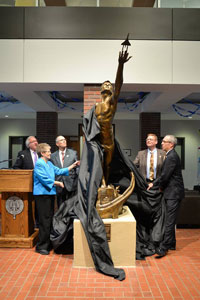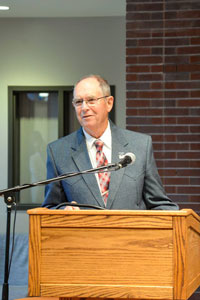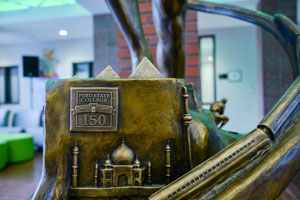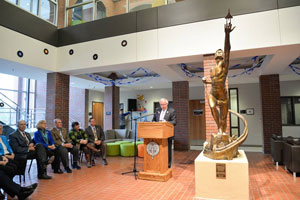Peru, Nebraska – Students, faculty, staff, alumni and friends of the College gathered in the lobby of the V.F. Jindra Fine Arts Building to unveil and dedicate Victor Issa’s Power of Thought Statue. The statue was installed on Thursday, October 26 and unveiled on Friday, October 27.
Daryl and Peggy Long commissioned the statue and asked the sculptor to include Peru State in its imagery. Daryl Long taught at Peru State for fifty years, from January 1967 to January 2017

Victor Issa, Peggy Long, Daryl Long, Todd Simpson and Dan Hanson unveiling the statue.
A plaque on the front of the plinth reads, Power of Thought, “Our hope is that those who view this sculpture will be inspired to add their own creative energies to the never-ending quest of humankind to expand the sphere of knowledge.”
“A gift to Peru State College from Dr. Daryl and Peggy Long, Professor of Science, 1967-2017. Victor Issa, Sculptor, October 27, 2017.”

Daryl Long speaking after the unveiling. He spoke on the joy of working, the joy of
watching the money earned grow and the joy of giving it away.
Issa writes that the inspiration for this statue came from “the amazing concept that a single thought could become a world-famous concert hall, an iconic sculpture, a trip to the moon or convert a collection of ordinary materials into what we grow to completely depend upon.”
Issa linked science, engineering and the arts in his work, where the base includes the Roman Colosseum, the Opera House in Sydney, Australia; a bust of Shakespeare; musical notes from Beethoven’s 5th Symphony; a transistor radio; Rodin’s “The Thinker” and Neil Armstrong’s footprint on the moon. At the suggestion of the Longs, the base also includes the Peru State sesquicentennial logo.

The Peru State Sesquicentennial Logo framed by the Taj Mahal and the Pyramids at the
base of the statue.
“Being an artist, I determined to include the arts … in pursuit of depicting technology, I decided to include the birthmarks of the tech age – the transistor radio,” Issa said. “Looking to the future, it was obvious to me that the biotech industry is now where technology was in the ’60s.”
The statue’s right hand pulls a strand of DNA liked to a bullet train, then a steam engine and the wheel. It’s left extends upward and outward, pushing out first a Wright Brothers Flyer and then a Concorde supersonic jet.

Victor Issa, sculptor of the statue, speaking after the unveiling.
###
